Petunia Flowers: Planting, Growing and Caring for Petunia Plants

Petunias are spectacular annual flowers that bloom in shades of yellow, red, purple, white, orange, and blue. Petunia flowers can be single or showy double blooms with striped, solid, or speckled colorful patterns. Blooming continuously on long cascading stems, petunia flowers look stunning, growing in containers, hanging baskets, flower borders, or spreading colorful ground cover. Petunias bloom throughout the summer, and new varieties will produce flowers non-stop without deadheading.
Wave petunias are among the most popular varieties of these mounding plants with trumpet-like flowers. There are hundreds of petunia varieties that include spreading or trailing petunia plants, large-leaved grandiflora petunias, robust multiflora petunias, and milliflora petunias with small flowers. Regardless of your garden or growing zone, there is a type of petunia for almost any garden landscape.
This article is a guide to planting, growing, and caring for petunia flowers. You will find out how to pick suitable varieties of blooming petunias to add summer color to your garden, patio, balcony, or container garden. Handy tips on growing petunias in hanging baskets, mixed flower beds, or pots will help you ensure that the showy, colorful flowers bloom all summer long.
Are Petunias Perennials or Annuals?
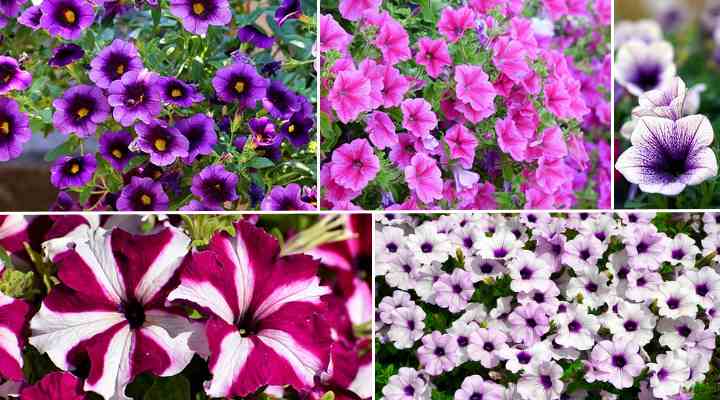
Petunias are tender perennials in warmer zones but treated as annuals in colder zones
Petunias are fast-growing tender perennial tropical plants that grow as flowering annuals in most regions. Petunia plants are not tolerant of frost or cold temperatures. In most climates, petunias can come back every year for two or three years if they’re protected from frost.
In USDA zones 10 and 11, most petunias grow as perennials in the ground. However, in colder zones, it’s necessary to treat petunias as annuals and overwinter them indoors. You can also take cuttings from petunias in late summer to grow new plants the following season when the weather warms up.
Petunia Cold Tolerance
Petunias don’t tolerate the cold. Petunia flowers grow slower when daytime temperatures drop below 61°F (16°C) and nighttime temperatures below 57°F (14°C). However, the tender perennials should survive if it’s as low as 39°F (4°C) outside. It’s crucial to protect petunias from extreme cold—if the temperature dips below 32°F (0°C), the thin leaves and flowers will die.
There are a few ways to help petunias tolerate cold temperatures better. For example, in the fall, when it gets below 57°F (14°C), you can protect petunias in the evening with sheets until the temperature warms in the morning.
It’s easier to protect petunias from cold temperatures if you grow the plants in hanging baskets or containers. If you expect cold weather, it’s easy to move the hanging basket flowers or pot to a warmer, sheltered location.
Do Petunias Need Sun or Shade?
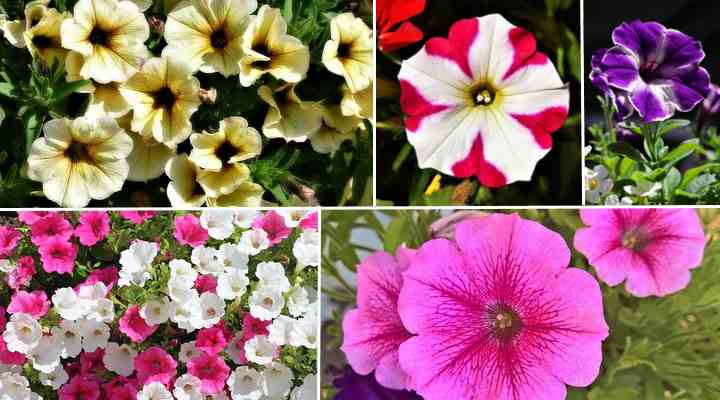
Petunias need plenty of sunlight to thrive
Petunias thrive in full sun when they get five or six hours of sunlight daily. Getting plenty of sunshine ensures that the cascading or mounding stems bloom all summer. If there’s too much shade and not enough sun, petunias become leggy and produce fewer blooms.
Petunias will continue to bloom, growing in full sun and heat as long as they grow in fertile soil that is kept moist.
Related reading: The best flowering perennials to grow in the shade.
How Long Do Petunia Flowers Last?
Petunia plants generally last two to three years growing as tender perennials outdoors in warm climates. To ensure that petunia flowers last longer in colder regions, it’s necessary to overwinter them indoors.
Petunias flowers start blooming in late spring and bloom freely until the end of summer. In full sun, petunias flowers bloom profusely all summer, sometimes until just before the first frost. Deadheading petunias also encourages denser foliage and more flowers, helping to extend the blooming season.
Types of Petunia Flowers
Petunias are among the most popular kinds of flowers to grow in window boxes, borders, containers, or hanging baskets. Their incredible range of colors, mounding growth, cascading floral stems, and easy care are the reasons why the sun-loving flowers are so desirable in gardens.
To ensure that beautiful petunia flowers grow best, it’s crucial to choose the right type of plant. Some petunias grow better as ground cover, whereas others are suitable for hanging baskets or window boxes. Some hardy petunia varieties thrive in hot, humid conditions.
Petunia flower varieties are generally classified by their flower and leaf size. Here are descriptions of the five groups of petunias:
Wave petunias are popular flowers for hanging baskets because of their trailing and spreading stems growing up to 4 ft. (1.2 m) long. The large, trumpet-shaped flowers bloom en mass, filling containers and borders with purple, lilac, pink, red, and blue flowers.

Wave petunia
Multiflora petunias have masses of small pink, red, white, purple, and multi-colored flowers. The showy floral displays can be single or double blooms. The sturdy cascading stems make these petunias ideal for windy or wet climates. These petunia flowers bloom well without much deadheading.
Grandiflora petunias are the largest flowers in petunia species. The funnel-like flowers have large, wavy petals and grow up to 5” (15 cm) large. To keep grandiflora petunias blooming, you’ll need to deadhead them regularly. Heavy rain tends to ruin the appearance of the flowers.
Supertunia petunias bloom continuously and are vigorous spreading plants. The large papery flowers grow in a range of pastel and bright neon colors. Some of the most spectacular Supertunia petunia flowers are varieties with striped or speckled flowers.
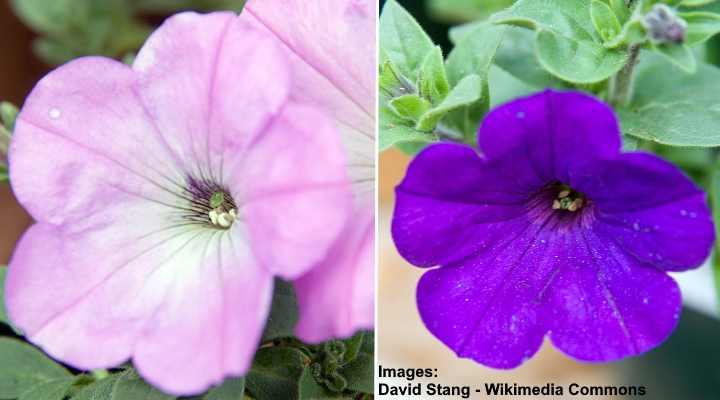
Supertunia petunia ‘Lavender Morn’ (left) and ‘Royal Velvet’ (right)
Cascadia and surfinia petunias are the two most popular petunia varieties for hanging baskets. The trumpet flowers have pronounced veining contrasting with the unusual flower colors and shades.
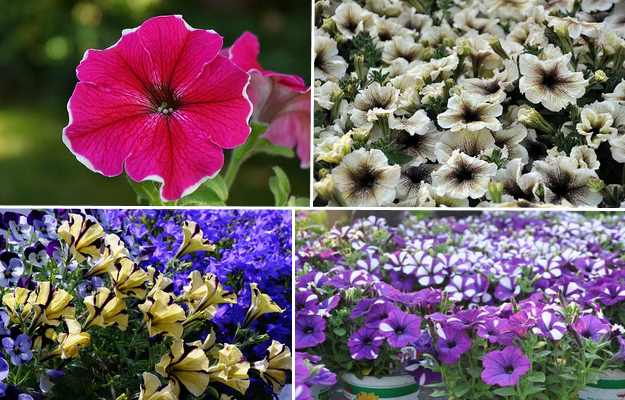
Surfinia petunias
Milliflora petunias have the smallest flowers from all the petunia groups. The small petunia flowers grow around 1” (2.5 cm) wide, and masses of colorful flowers cover the mounding foliage throughout the season.
Calibrachoa or Million Bells have small flowers that look like petunias. Species of Calibrachoa are related to petunias and have a similar spreading growth habit. The petunia-like calibrachoa flowers are funnel-shaped in beautiful pastel shades. The flowers typically have pronounced colorful veins and a contrasting dark center.
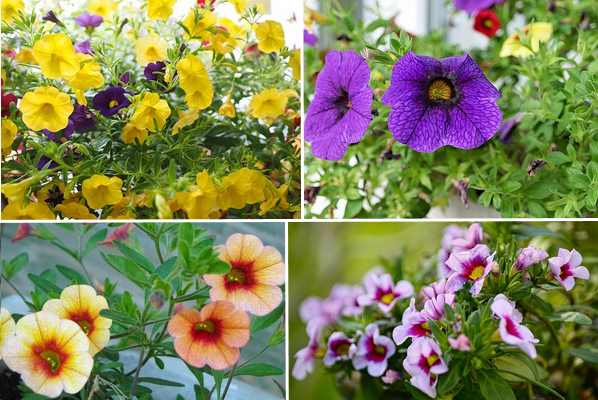
Calibrachoas (million bells) look similar to petunias and were once in the same genus, however are now in a separate genus
Petunia Flowers
Petunia flowers are small to large trumpet-shaped or funnel-like flowers that bloom profusely on stems. In full bloom, petunia plants can look like a mound of colorful flowers. Flowers consist of five fused petals. Typically, the center of the flowers and veins are a darker shade of color than the petals.
Petunia flowers come in all shades of colors. Petunia flowers can have bright, vibrant red, blue, purple, or yellow colors, or subtle shades of pastel yellow, lilac, pink, or white colors. There are even varieties of petunias with black flowers.
Petunia petals can be smooth or ruffled, and the most spectacular petunia flowers are double blooms. Depending on the variety, flowers can have solid colors or have contrasting striped or speckled patterns.
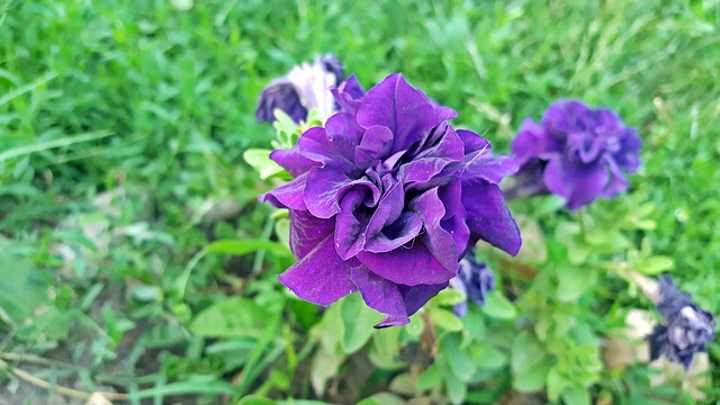
Double bloom petunia
How do long petunia plants bloom?
Petunia flowers bloom throughout the summer until early fall. Newer hybrids such as wave petunias don’t require deadheading to extend the flowering season. Varieties of petunias such as grandiflora petunias flower longer if you regularly snip off dead or dying flowers.
To encourage a long blooming period, it’s vital to water petunias well, especially in hot, sunny weather. Apart from extreme heat or humidity, you can expect flowers on petunias to last the summer.
How much time does it take petunia to bloom?
Petunias are the easiest and quickest blooming flowers to grow from seed. They take between six and eight weeks from germinating until flowering. Typically, petunias are fast growers if the seedlings get plenty of light and grow in fertile, moist soil. This means keeping the seedlings between 65°F and 75°F (18°C – 24°C) and they will germinate in five to 15 days.
How to keep petunia blooming
Most varieties of petunias bloom longer if you remove the dying flowers. Removing flowers encourages the plant to produce more flowers rather than creating seed pods. It may not be practical to deadhead masses of flowers if you grow petunias as border plants or ground cover. However, it’s best to deadhead petunias growing in hanging baskets or containers.
Deadheading Petunia
Deadheading petunias keeps the bushy, cascading plant full of flowers from late spring until late summer. Petunias grow as annuals and reproduce by producing seeds after flowering. If you snip off wilting flowers, you will encourage the plant to continue blooming throughout the whole growing season.
How to Prune Petunia: Pruning petunias is straightforward if you want to remove the flowers. Use your fingers to pinch flowers and seed pods once they turn brown. Then prune the stems just above the next set of leaves. The petunia will produce more leaves and flowers from the cut stem.
How to Plant Petunia Flowers
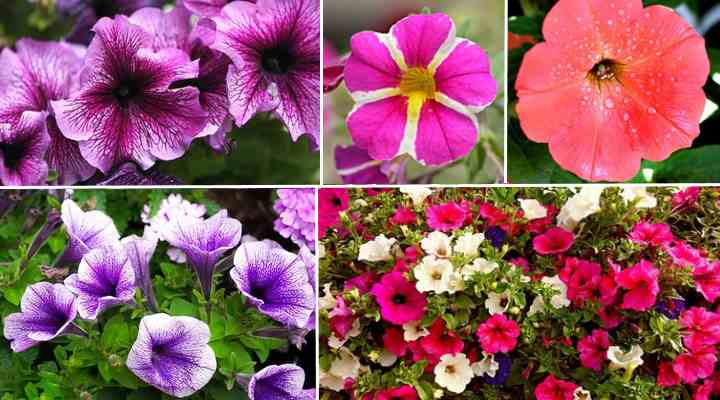
When growing petunia from seeds or cuttings, grow them indoors until temperatures warm up before moving them outdoors
Growing petunias from seed, transplants, or cuttings is relatively straightforward. It’s usually best to start petunias indoors before transplanting them to the garden, outdoor container, or hanging basket.
When to plant petunia: When starting petunias indoors, it’s best to sow the seeds ten to 12 weeks before your last frost date. You can plant petunias outdoors when nighttime temperatures are between 55°F and 65°F (12°C – 18°C), and it’s around 65°F (18°C) during the day. After planting outdoors, petunias should start flowering relatively quickly.
Where to plant petunia: Grow petunias where they get full sun for at least six hours a day. In hot climates, it’s best to plant them where they get some afternoon shade. Petunias will tolerate some shade, but they won’t flower as well as in the full sun.
The best soil for growing petunia: Petunias grow best in fertile, well-draining soil with a pH level between 6 and 6.5 (slightly acidic). When planting spreading petunias in the ground, work in compost and peat moss to amend the soil. In hanging baskets, petunias grow best in a soilless mix containing slow-release fertilizer.
How to grow petunia from seed: Petunia seeds can be tricky to germinate due to their minute size. To grow petunias flowers from seed, spread some seeds sparingly on damp potting soil and spray with a fine mist. Cover with plastic and put in a sunny location, out of direct sunlight and temperatures between 70°F and 85°F (21°C – 29°С).
When seedlings emerge, remove the plastic, and put the seedling container where the air temperature is around 65°F (18°C). Put under fluorescent lights, so they get between 16 and 18 hours of light daily. When seedlings have at least three leaves, transfer to individual pots to continue growing.
How to Care for Petunia Flowers
To care for petunias, water the ground once a week during the growing season to keep it moist but never soggy. Petunia flowers grow best in full sun with some afternoon shade in hot climates. Feed petunias with a balanced fertilizer every three weeks or weekly for spreading petunias.
How to Care for Petunias in Pots: Petunia Container Care
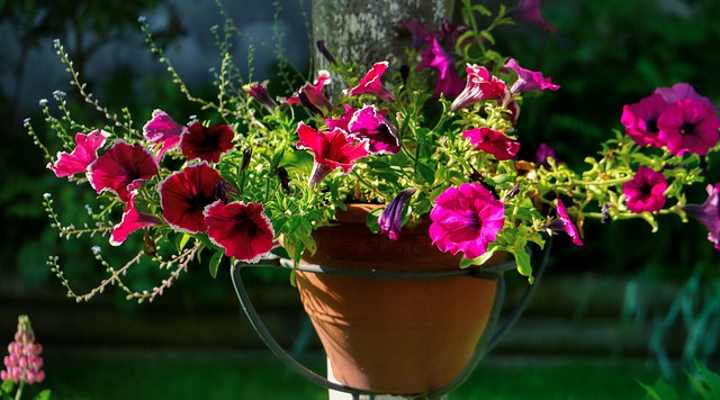
To care properly for your potted petunia, make sure to use well-draining soil and water when the top layer is dry
To grow petunias in containers, use a loose, well-draining potting mix. Water the potting mix every two to three days, thoroughly drenching the soil. As a rule, allow the top layer of soil to dry between watering. Petunias are heavy feeders, so apply a diluted liquid fertilizer every two weeks.
As with growing petunias in the ground, choose a sunny spot where the plants get six to eight hours of daily sunlight for best growth and the fullest possible petunia flowers.
How to Care for Petunias During Winter
Many gardeners like to overwinter fancy petunia hybrids during winter. In winter, to care for petunias, cut the plants back to about 2” (5 cm) before the first frost. Plant in individual pots and put the petunias in a cool, dark place, while keeping the potting soil slightly moist during winter.
Alternatively, you can take petunias cuttings before frost arrives in the fall. Root the cuttings in individual jars of water and transfer them to small pots when roots appear. Place on a sunny windowsill and ensure the soil is kept slightly moist.
In spring, after the last frost, you can plant overwintered petunias in hanging baskets, containers, along shrub borders, or as a spreading bedding plant for full sun ground cover.
Petunia Propagation
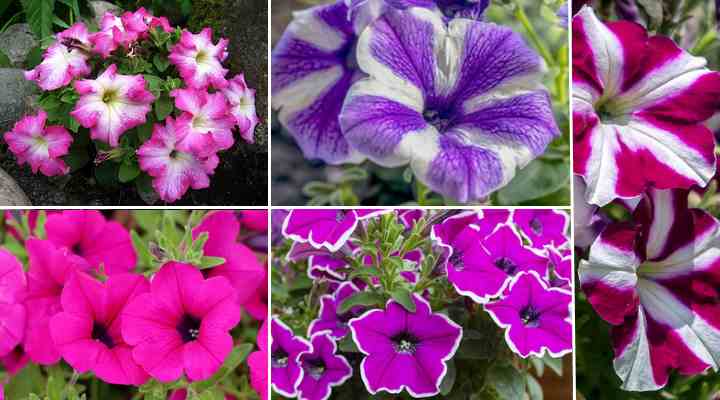
The best and fastest way to propagate petunia is by stem cuttings
Propagating petunias by stem cuttings is the fastest way to grow the flowers. Take healthy petunia cuttings in the fall. Snip 3” to 5” (7.5 – 15 cm) stems just below the nodes and remove the lower leaves. In a small pot containing peat moss and perlite, insert the petunia cutting and press round the soil to make it firm.
Mist the soil and cover the cuttings with plastic, ensuring that it doesn’t touch the stems. Place in a cool, shaded location. Lightly mist the soil every second day. It should take between three and four weeks for the cuttings to root. Once rooted, place in a sunny location and grow throughout the winter.
In spring, you can transfer petunias growing indoors in pots to your garden or hanging baskets outdoors.
How Often to Water Petunia
The frequency of watering petunias depends on where the flowering plants are growing. Bushy or mounding petunias growing in the ground need watering once a week. Spreading petunias may require watering more often.
Petunias growing in hanging baskets or containers dry out faster. Therefore, you should water them once a day during hot weather and sometimes twice a day if it’s exceptionally scorching.
Petunia in Hanging Baskets

Petunia flowers are commonly used in hanging baskets to add color to porches and entrances
Petunias are among the most popular hanging basket plants due to their abundant colorful, showy blooms, cascading stems and easy-care growth. Petunias growing in hanging baskets are ideal for hanging at entranceways, from a porch, arbor, or pergola. Varieties of wave petunias with their ruffled, double flowers are especially attractive in hanging baskets.
How to plant petunia in hanging baskets: Choose cascading, surfinia, or wave petunias to grow in hanging baskets. Use a lightweight potting mix that has excellent drainage and a suitable basket with a drainage hole. Because the soil in hanging baskets leaches nutrients fast, use slow-release fertilizer in the potting soil.
How to care for petunia in hanging baskets: Adequate watering is critical to ensure the long cascading stems produce an abundance of flowers. Water petunias in hanging baskets when the top layer of soil dries. During the growing season, this means watering petunias as often as once or twice a day.
When watering petunias in containers or hanging baskets, here are a few things to remember:
- Always water the soil, not the leaves or flowers
- Never let the potting mix stay continually wet
- Petunias are not drought-tolerant plants and grow better when you water them deeply and regularly
What Causes Petunias to Wilt and Die
Improper watering is the most common reason for petunias to droop and stop growing. Petunias thrive in moist soil, so ensure that the soil never dries out completely. But keep your petunia healthy by always watering it when the soil partially dries. In contrast, too much watering can kill a petunia by causing root rot.
Other reasons for petunias wilting and dying are too much shade or a pest infestation
Leggy Petunias
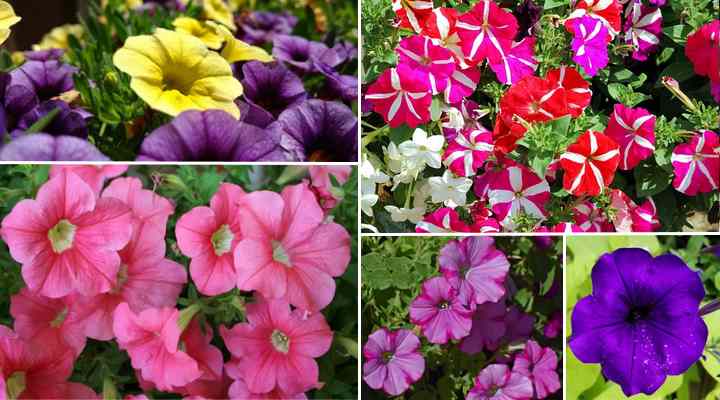
To prevent leggy growth, make sure your petunia plant gets enough sunlight and adequate watering
Petunias that start growing long stems with few leaves and blooms usually lack sunlight. However, leggy petunias can also mean that they don’t have enough moisture. Putting the petunias container or hanging basket in a sunnier location and watering regularly usually resolves gangly growth.
Another reason for leggy, unattractive stems with flowers at the end of the stems is because your petunia needs deadheading. Be in the habit of removing the flowers and seed pods after the blooms die.
To restore bushy growth to a leggy petunia, prune stems by one quarter or one half. Heavy pruning can result in growing a compact, bushy plant that produces a profusion of trumpet flowers.
Yellow Leaves on Petunia Plants
Petunia foliage that turns yellow is typically a sign of overwatering or poorly draining soil. However, nutritional deficiencies can also be to blame for yellow petunia leaves.
To help bring back healthy growth, ensure that the petunia grows in the ground or a potting mix that drains well. You may need to amend the soil with peat moss and perlite to improve drainage. Additionally, only water the ground or container when the top layer of soil is dry.
Suppose you suspect the petunia has yellow leaves due to a lack of nutrients. In that case, you’ll need to fertilize it more regularly. Apply a balanced fertilizer every two weeks to encourage healthy growth.
Petunia Not Blooming
Petunias without flowers or with few blooms usually occur when there is inadequate light. Petunias need at least six hours of full sun to produce plenty of colorful flowers. To resolve this issue, put a non-blooming petunia in full sunlight and water it regularly to keep the soil moist.
Related articles:
- The Best Flowers for Hanging Baskets
- Types of Colorful Petunia Flowers
- Wax Begonia: Flower, Leaves – Plant Care Guide
